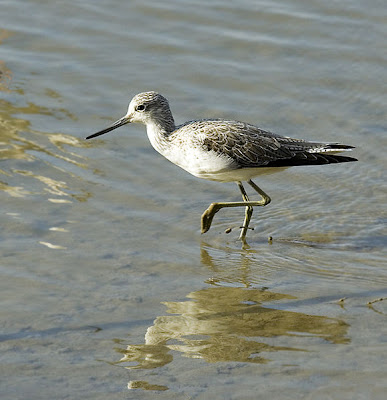Belongs within: Scolopacidae.
Tringa, the shanks and wood sandpipers, is a genus of medium-sized long-legged shorebirds with relatively slight changes in plumage between breeding and non-breeding seasons. Most species have the upperparts marked with more or less conspicuous white spots though the tattlers T. brevipes and T. incana are uniformly dark grey above.
Characters (from Ridgway 1887, as Totanus*): Ears situated well posterior to eyes; exposed culmen more than one-fifth as long as wing; bill narrow at tip, where hard and smooth on top, tip of upper mandible thin with cutting edges far apart. Wing more than 110 mm long; axillars white or barred with white and dusky. Tail not more than half as long as wing, longer than exposed culmen. Back of tarsus with continuous row of transverse scutellae; hind toe present; middle toe united to one or both lateral toes by distinct web.
*Due to different type species designations, many authors in the 19th and early 20th centuries applied the name Tringa to species now included in the genus Calidris.
<==Tringa Linnaeus 1758 CC10 (see below for synonymy)
|--+--*T. ochropus Linnaeus 1758 CC10, JT12, M02 [=T. ocropus M02]
| `--T. solitaria JT12
`--+--+--T. brevipes (Vieillot 1816) CC10 (see below for synonymy)
| `--T. incana (Gmelin 1789) CC10 (see below for synonymy)
`--+--+--T. flavipes (Gmelin 1789) JT12, CC10 (see below for synonymy)
| `--T. semipalmata BKB15 [=Catoptrophorus semipalmatus JT12]
`--+--+--T. erythropus Linnaeus 1758 JT12, M02
| `--+--T. melanoleuca (Gmelin 1789) JT12, CC10 [=Totanus melanoleucus A61]
| `--T. nebularia (Gunnerus 1767) JT12, CC10 (see below for synonymy)
`--+--T. stagnatilis (Bechstein 1803) JT12, CC10 (see below for synonymy)
`--+--T. glareola Linnaeus 1758 JT12, M02 [incl. Rhyacophilus glareola picturata Mathews 1916 WS48]
`--T. totanus (Linnaeus 1758) JT12, M02 (see below for synonymy)
|--T. t. totanus I92
`--T. t. eurhinus (Oberholser 1900) I92
Tringa incertae sedis:
T. edwardsi (Gaillard 1908) [=Totanus edwardsi] M02
T. gambetta Linnaeus 1758 L58
T. gracilis Milne-Edwards 1868 [=Erolia gracilis] M02
T. grigorescui Kessler & Gál 1996 M02
T. guttifer (Nordmann 1835) I92
T. littorea Linnaeus 1758 L58
‘Totanus’ minor Ennouchi 1930 (see below for synonymy) M02
T. numenioides (Serebrovs’kyj 1941) [=Totanus numenioides, Tr. numenioidea] M02
T. ocrophus Linnaeus 1758 L58
‘Totanus’ praecursor Laube 1901 M02
T. scarabellii (Portis 1887) [=Totanus scarabellii] M02
‘Totanus’ minor Ennouchi 1930 non Tringa cinclus minor Schlegel 1844 (not preoc. if in dif. gen.) [=Erolia ennouchii Brodkorb 1967] M02
Tringa Linnaeus 1758 CC10 [=Trynga Moehring 1758 CC10; incl. Erythroscelus Kaup 1829 B94, Glottis Koch 1816 CC10, Heteractitis Stejneger 1884 CC10, Heteroscelus Baird 1858 CC10, Iliornis Kaup 1829 CC10, Totanus Bechstein 1803 CC10; Erythroscelini, Totanini, Tringini]
Tringa brevipes (Vieillot 1816) CC10 [=Totanus brevipes CC10, *Heteractitis brevipes CC10, *Heteroscelus incanus brevipes CC10, JT12]
Tringa flavipes (Gmelin 1789) JT12, CC10 [=Scolopax flavipes CC10, Gambetta flavipes B49, Totanus flavipes S18]
Tringa incana (Gmelin 1789) CC10 [=Scolopax incana CC10, Heteractitis incanus CC10, Heteroscelus incanus JT12, Totanus incanus CC10]
Tringa nebularia (Gunnerus 1767) JT12, CC10 [=Scolopax nebularia CC10, Glottis nebularius CC10; incl. S. glottis Latham 1787 CC10, Totanus glottis CC10, *Glottis glottis CC10, To. glottoides Vigors & Gould 1831 CC10]
Tringa stagnatilis (Bechstein 1803) JT12, CC10 [=Totanus stagnatilis CC10, *Iliornis stagnatilis CC10; incl. I. stagnatilis addenda Mathews 1915 CC10]
Tringa totanus (Linnaeus 1758) JT12, M02 [=Scolopax totanus M02, Totanus totanus B49; incl. *To. maculatus CC10]
*Type species of generic name indicated
REFERENCES
[A61] Austin, O. L., Jr. 1961. Birds of the World: A survey of the twenty-seven orders and one hundred and fifty-five families. Paul Hamlyn: London.
[B49] Baker, E. W. 1949. A review of the mites of the family Cheyletidae in the United States National Museum. Proceedings of the United States National Museum 99 (3238): 267–320.
[B94] Bock, W. J. 1994. History and nomenclature of avian family-group names. Bulletin of the American Museum of Natural History 222: 1–281.
[BKB15] Burleigh, J. G., R. T. Kimball & E. L. Braun. 2015. Building the avian tree of life using a large-scale, sparse supermatrix. Molecular Phylogenetics and Evolution 84: 53–63.
[CC10] Checklist Committee (OSNZ). 2010. Checklist of the Birds of New Zealand, Norfolk and Macquarie Islands, and the Ross Dependency, Antarctica 4th ed. Ornithological Society of New Zealand and Te Papa Press: Wellington.
[I92] Iwahashi, J. (ed.) 1992. Reddo Deeta Animaruzu: a pictorial of Japanese fauna facing extinction. JICC: Tokyo.
[JT12] Jetz, W., G. H. Thomas, J. B. Joy, K. Hartmann & A. Ø. Mooers. 2012. The global diversity of birds in space and time. Nature 491: 444–448.
[L58] Linnaeus, C. 1758. Systema Naturae per Regna Tria Naturae, secundum classes, ordines, genera, species, cum characteribus, differentiis, synonymis, locis. Tomus I. Editio decima, reformata. Laurentii Salvii: Holmiae.
[M02] Mlíkovský, J. 2002. Cenozoic Birds of the World. Part 1: Europe. Ninox Press: Praha.
Ridgway, R. 1887. A Manual of North American Birds. J. B. Lippincott Company: Philadelphia.
[S18] Stone, W. 1918. Birds of the Panama Canal Zone, with special reference to a collection made by Mr. Lindsey L. Jewel. Proceedings of the Academy of Natural Sciences of Philadelphia 70: 239–280.
[WS48] Whittell, H. M., & D. L. Serventy. 1948. A systematic list of the birds of Western Australia. Public Library, Museum and Art Gallery of Western Australia, Special Publication 1: 1–126.
Last updated: 10 August 2019.

No comments:
Post a Comment
Markup Key:
- <b>bold</b> = bold
- <i>italic</i> = italic
- <a href="http://www.fieldofscience.com/">FoS</a> = FoS